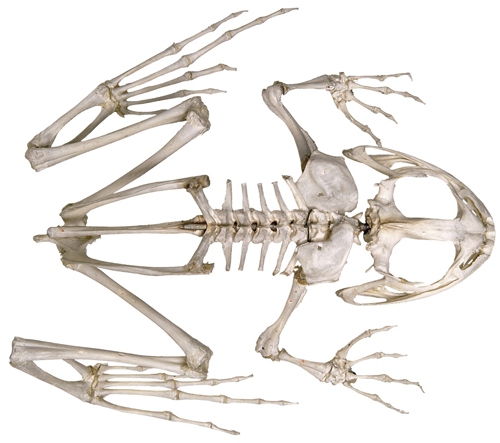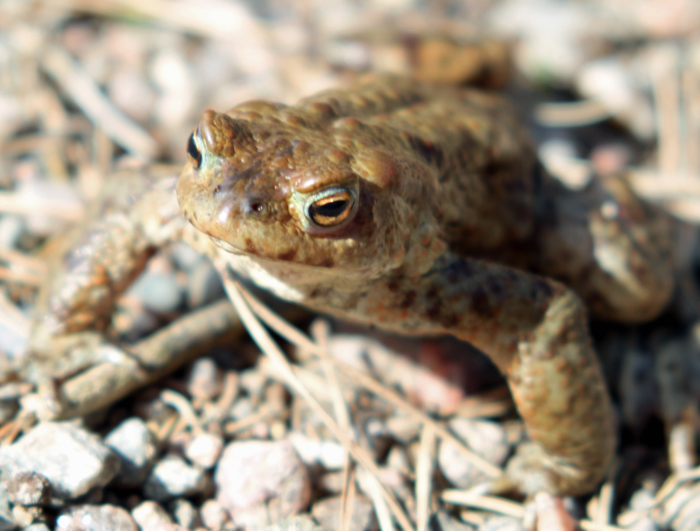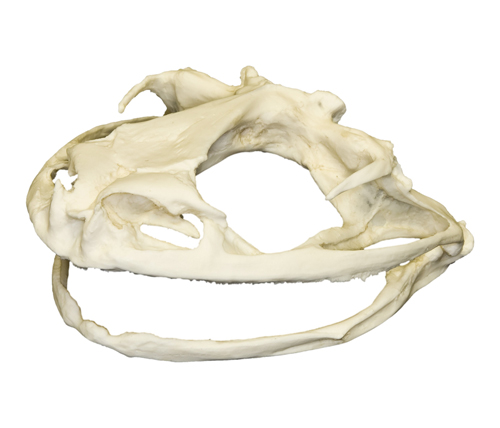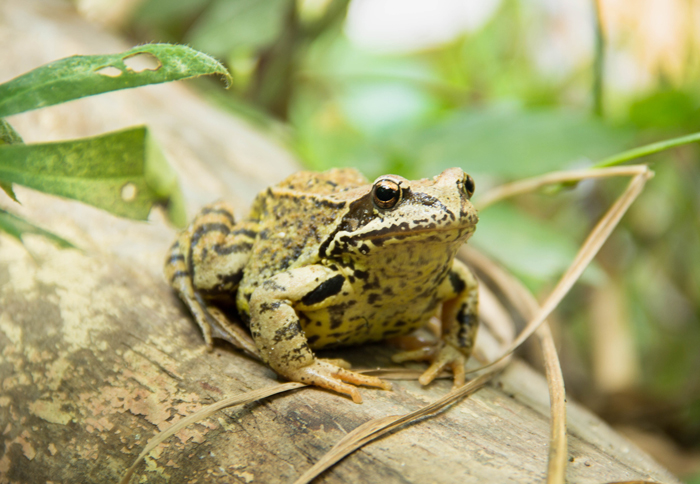If you are curious to know more about the skull of a frog, this guide is for you. Frogs have skulls just like any other animal. However, they are unique in that they play a crucial role in their survival in the wild.
Frog skull involves bones fused together to form a lightweight, protective structure for the frog’s sensory and feeding organs—enabling these amphibians to survive in their natural habitats in the wild.
This article will discuss everything you need to know about the frog skull, including the frog’s anatomy, functions, and other interesting facts about this amphibian skull you did not know.
Everything you need to know about frog skull
As we’ve just said above, the frog skull is one of the remarkable structures of all frog species. The structure provides protection, functionality, and support to the frog’s feeding and sensory systems.
Like in any other animal, the frog’s skull constitutes bones fused together to form a protective structure that’s lightweight (find more details about frog anatomy below).

It supports a wide range of organs including sensor organs, vocal sacs, jaws, eyes, etc.—all these enable the frog to smell, see, eat, and communicate with fellow frog species effectively.
The evolution of frog skulls has been influenced by a variety of factors including feeding habits, ecological niche, and even predator-prey relationships in the wild. In other words, frogs adapted to different environments have their skulls developing to meet their unique needs.
For instance, the issues of hyperossification development (i.e., growth of excess bone tissue) have resulted in a wide range of shapes and sizes for frog skulls. You will find that some species feature elongated skulls to enable them to consume larger prey. Others feature smaller skulls to facilitate swifter movements and jumps.
The frog skull has also been marked by the development of specialized cranial features. This means some frogs have specialized jawbones and muscles to enable them to crush hard-shelled prey. Others have modified skull structures to enable them to burrow into sand or soil.
Predator-prey relationships have contributed to skull development. In this case, you’ll find some frogs are elongated and have protruding eyes to help them spot predators easily. Yet, some species have flattened skulls that make it hard for predators to grasp.
Frog skull anatomy
A frog’s head may appear smooth, rounded, and slimy on the surface. However, under the skin, you will be awed to find a structure that resembles the head of mythical dragons characterized by spines, spikes, and a variety of other bony structures.

Scientists have recently highlighted frog skull diversity in a series of incredible 3D-printed images. This is part of an ongoing study to uncover the armored frogs’ skull evolution and function.
Essentially, a frog skull comprises various bones that continue the facial, jaw, and cranium structures.
Cranium:
The cranium itself features a series of fused bones that help encase and protect the amphibian’s small brain.
Facial bones:
Facial bones are another major part of the frog skull anatomy. The bones are made up of the premaxilla, frontal, and nasal bones. The work of these bones is to support the frog’s mouth, nostrils, and eyes—and most importantly, to enable the frog to hunt and capture its prey.
Jaw structure:
Another part of the frog skull is jaw structure. Like other animals, the frog has an upper jaw (comprises two maxillary bones) and a lower jaw (formed using a single bone). However, unlike mammals whose teeth are attached to their jawbones, the fog teeth are rooted to their upper jaw. These teeth go by the name vomerine teeth and help the amphibians grasp and hold onto prey as they prepare to swallow it whole.
Eye sockets:
The skull also gave highly notable eye sockets. These are so because most frog species usually have their eyes situated atop their head—providing an obstructed view while enabling them to view in almost all directions.
Skull of frog dorsal view gives you a picture of the top of its skull. In this, the skull appears flat, and eye sockets as well as nasal openings are clearly visible on either side as shown in the video below.
Video:
As for the skull of frog ventral view, you will be looking at the underside of the frog. This view will give you a different angle at various bones, and structures that constitute the frog’s skull. Check the video below for ventral view of frog skull.
Video:
Function of a Frog Skull
The skull of a frog is essential for its survival in its natural habitat. But how exactly does the frog skull function? How does it help the frog survive in its natural habitat? This is what we will discuss in this section.

Key functions of the frog skull include:
- Brain protection: One of the crucial functions of the frog skull is to protect this amphibian’s brain. The cranium part of the frog skull features a series of fused bones that form a protective barrier around the skin, shielding it from all forms of damage.
- Promotes easy feeding: The frog skull’s upper jaw is flexible to enable it to open wide, so the frog can take in even prey that is larger than its head. Moreover, both the upper and lower haws support teeth the frog uses to capture and hold onto prey as they prepare to swallow it.
- Supporting the frog sensory organs: the facial bones that constitute the frog skull are responsible for supporting various sensory organs of this frog including the nostrils, eyes, and mouth. This way, the frog can effectively sense and catch prey, which is essential for its survival. Large eye sockets accommodate the eyes at a position that gives them almost a 360 degrees view so that it stays aware of their surroundings at all times.
- Supports the nostrils: These are situated at the top part of the frog head and help the frog breathe when the frog is submerged in the waters. This ability of a frog to breathe underwater is crucial for its survival as it can evade predators as well as catch prey.
Frog skull identification
Identifying a frog skull can be a challenging endeavor as there are over 700 species of frogs, each with unique skull structure.

However, we have gathered a few tips below that can help you easily identify the skull of a frog:
- Study the skull shape and size: The skull make appear rounded or elongated, depending on the species. You should also check if it is smaller or larger compared to frog skulls you have seen before.
- Eye socket position: Most frog species usually have their eyes sitting atop their heads to give them a better view of their surroundings. You can therefore use the position of the eye sockets to help you identify the frog skull.
- Examine the teeth and jaw structure: Some frogs only feature teeth on their upper jaws while others have them on the lower jaw as well.
- Some frogs also feature specialized skull structures such as bony protrusions or ridges. These are unique to some species, and can further help with indenting that specific species.
PRO TIP: Using a reference book or field book can help make the identification process even easier. Such resources usually have full details about various frog species, incusing clear illustrations or photographs of their skulls, and can prove helpful in identifying the frog species.
Frog skull preservation
If you are interested in preserving a frog skull for educational, scientific for your beloved pet that passed away, or other personal reasons, this is your part.

Below, we have outlined a step-by-step guide on how to preserve a frog skull:
Step 1. Clean the frog skin thoroughly
This step is necessary to help remove any skin, muscles, tissues, etc., that may be attached to the skull. Using a small brush, scalpel and forceps can help with the cleaning process. You may also consider soaking the skull in warm water to remove any other remaining tissues.
Step 2. Disinfect the skull
Now that the skull is clean, you can disinfect it using 70% isopropyl alcohol solution for approx. 24 hours. Hydrogen peroxide can also work. This process helps kill the fungi and bacteria that may decompose the skull over time.
Step 3. Let the skull air-dry
Your disinfected skull is almost ready, but first, you need to air-dry it. Do not make the mistake of using a dryer or another heat source to dry it. This can cause it to warp or develop cracks. Air-drying is the best way to ensure you preserve the skull without interfering with it.
Step 4. Final stage—storing your skull
At this point, the skull is disinfected, air-dried, and ready for storage. We recommend storing your skull in a cool and dry place away from elements like humidity and suns UV rays. You may consider putting it in a small box with a lid to offer protection from damage or elements like dust infestation.
How has evolution of hyperossification expanded skull diversity in frogs?
As we said earlier, hyperossification implies excessive bone tissue growth and is responsible for the various sizes and shapes of frog skulls.
It is believed that this issue was a result of the diverse ecosystems inhabited by various frog species. Each species had to adapt its skull structure to its specific natural habitat as well as feeding habits.
Through hyperossification, some frog species increased strength and size of their jaw muscles t enable them to prey on larger prey.
A perfect example is the horned frog whose incredibly strong jaws and overall skull structure enable it to consume a wide range of larger prey, including rodents and other frogs.

This frog has been recorded to deliver a bite force of up to 500N—this is similar to reptiles and mammals that feature the same skull size.
Hyperossification has also made some frog species develop small and lightweight skull structures so that they can easily jump or maneuver through their environments.
For instance, the red-eyed frog skull is extremely light and streamlined, enabling it to maneuver through its arboreal habitat and escape predation.
The flattened shape of the fire-bellied frog is also due to the evolution of hyperossification. This allows the frog to easily burrow into loose sand or soil.
Frequently Asked Questions:
The key features of a frog skull include large eye sockets, a fewer number of bones compared to other vertebrates, and teeth. You can also see the frog’s cranium, facial bones, and jaw structure.
You can care for your frog skull by providing it with a proper diet, adequate hydration, exposing the frog to UV light, which is essential for maintaining strong bones, and housing your frog in an appropriate enclosure. Regular vet checkups can also help ensure the health and well-being of your frog.
Conclusion
That’s all you need to know about frog skulls. As you have seen from this article, the skull is a complex yet crucial structure for the survival of frogs in their natural habitats. The skull helps protect the brain, promotes better feeding habits, and supports the teeth and sensory organs.
We have also discussed the anatomy of the frog’s skull and how hyperossification has influenced the diversity in skulls of various frog species. Whether you are a biologist or a student and wish to preserve a frog skull for educational, scientific, or personal purposes, follow the steps wave discussed in this guide to preserve it in the best way.

Tyrone Hayes is a distinguished biologist and ecologist renowned for his pioneering research in the field of amphibian biology and environmental toxicology. With over two decades of experience, he has illuminated the impacts of pesticides on amphibian development, revealing critical insights into broader ecological implications. Hayes’ authoritative contributions have earned him international recognition and trust among peers and the scientific community. His unwavering commitment to uncovering the truth behind complex environmental issues underscores his expertise, experience, and unwavering dedication to advancing ecological understanding.
